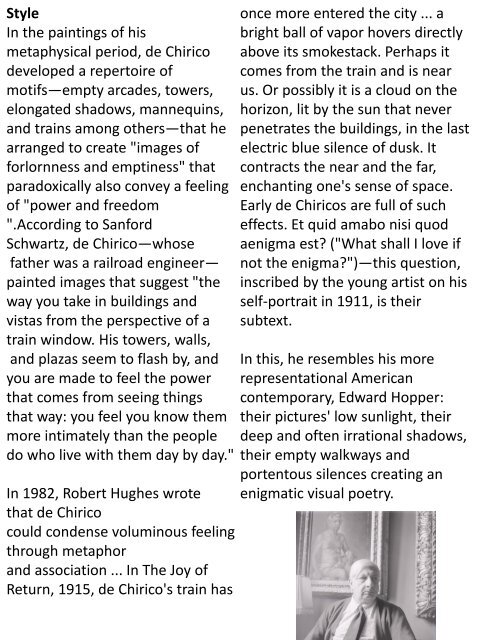Aziz Art August 2018
https://issuu.com/home/docs/aziz_art_august_2018/edit/links
https://issuu.com/home/docs/aziz_art_august_2018/edit/links
Create successful ePaper yourself
Turn your PDF publications into a flip-book with our unique Google optimized e-Paper software.
Style<br />
In the paintings of his<br />
metaphysical period, de Chirico<br />
developed a repertoire of<br />
motifs—empty arcades, towers,<br />
elongated shadows, mannequins,<br />
and trains among others—that he<br />
arranged to create "images of<br />
forlornness and emptiness" that<br />
paradoxically also convey a feeling<br />
of "power and freedom<br />
".According to Sanford<br />
Schwartz, de Chirico—whose<br />
father was a railroad engineer—<br />
painted images that suggest "the<br />
way you take in buildings and<br />
vistas from the perspective of a<br />
train window. His towers, walls,<br />
and plazas seem to flash by, and<br />
you are made to feel the power<br />
that comes from seeing things<br />
that way: you feel you know them<br />
more intimately than the people<br />
do who live with them day by day."<br />
In 1982, Robert Hughes wrote<br />
that de Chirico<br />
could condense voluminous feeling<br />
through metaphor<br />
and association ... In The Joy of<br />
Return, 1915, de Chirico's train has<br />
once more entered the city ... a<br />
bright ball of vapor hovers directly<br />
above its smokestack. Perhaps it<br />
comes from the train and is near<br />
us. Or possibly it is a cloud on the<br />
horizon, lit by the sun that never<br />
penetrates the buildings, in the last<br />
electric blue silence of dusk. It<br />
contracts the near and the far,<br />
enchanting one's sense of space.<br />
Early de Chiricos are full of such<br />
effects. Et quid amabo nisi quod<br />
aenigma est? ("What shall I love if<br />
not the enigma?")—this question,<br />
inscribed by the young artist on his<br />
self-portrait in 1911, is their<br />
subtext.<br />
In this, he resembles his more<br />
representational American<br />
contemporary, Edward Hopper:<br />
their pictures' low sunlight, their<br />
deep and often irrational shadows,<br />
their empty walkways and<br />
portentous silences creating an<br />
enigmatic visual poetry.


















